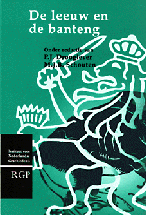The Lion and the Buffalo
The Lion and the Buffalo. Contributions for the congress on Dutch-Indonesian relations 1945-1950, held in The Hague from 27-29 March 1996, P.J. Drooglever and M.J.B. Schouten (1997)
 The Lion, symbolising the ambitions of the Netherlands, locked in mortal combat with the buffalo, representing the spirit of Indonesian nationalism. Both illustrate here the ferocity that was an integral part of the struggle for Indonesia’s independence. The decolonisation of Indonesia, a process which ended from a political perspective during the latter half of the 1940s, but in some respects continued into the early sixties, was the theme of a congress held in The Hague at the end of March 1996 entitled De Leeuw en de Banteng [trans. The Lion and the Buffalo]. The congress was organized on the occasion of the publication of the twentieth and final volume of the Officiële bescheiden betreffende de Nederlands-Indonesische betrekkingen 1945-1950. [trans. ‘Policy papers on Dutch-Indonesian relations 1945-1950’].
The Lion, symbolising the ambitions of the Netherlands, locked in mortal combat with the buffalo, representing the spirit of Indonesian nationalism. Both illustrate here the ferocity that was an integral part of the struggle for Indonesia’s independence. The decolonisation of Indonesia, a process which ended from a political perspective during the latter half of the 1940s, but in some respects continued into the early sixties, was the theme of a congress held in The Hague at the end of March 1996 entitled De Leeuw en de Banteng [trans. The Lion and the Buffalo]. The congress was organized on the occasion of the publication of the twentieth and final volume of the Officiële bescheiden betreffende de Nederlands-Indonesische betrekkingen 1945-1950. [trans. ‘Policy papers on Dutch-Indonesian relations 1945-1950’].
This volume contains the texts of papers given at the congress by historians and journalists from the Netherlands, Indonesia, Australia and the United States. Fourteen contributions examine the intentions of the key players and those involved (for example, the Netherlands represented by Lieftinck, Sassen and Romme; the Dutch East Indies represented by Van Mook and Beel; the Republic of Indonesia represented by Sjahrir, Sjarifoeddin and Sastroamidjojo; the Indonesian army known as the TNI under the command of Sudirman and the KNIL/KL led by Spoor). Five papers explore the role of historiography and public opinion.
In addition to the many different viewpoints presented by the experts, an extra dimension was added by personal testimonies from a number of Indonesian participants. Both the leading Republican politician Ali Budiardjo and the retired TNI General Purbo S. Suwondo responded to the paper presented by Salim Said entitled ‘The political involvement of the Indonesian military during the independence revolution and its impact on contemporary Indonesian politics‘ (De Leeuw en de Banteng, pp. 14 and 168-189). The complete text of their comments are provided below. Copyright for both items remains with the authors.
- The genesis of the Indonesian National Army and some political implications
Purbo S. Suwondo - Comments on Said Salim's paper
Ali Budiardjo

